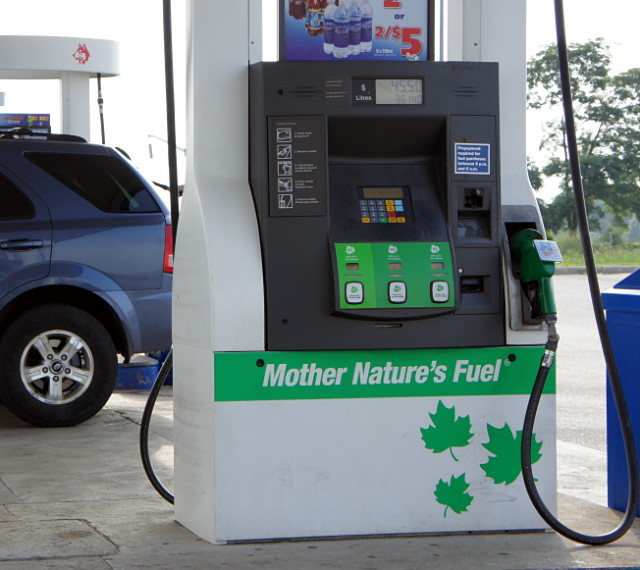Here’s a lovely bit of greenwashing. So you take a dollop of tar sands oil, mix in a dash of food, and you end up with “Mother Nature’s Fuel,” as Husky calls its ethanol-blended gasoline. It sounds so clean and wholesome.
Category: environment
By-law roulette #4
Section 844-23 (PDF) of the Toronto Municipal Code states that:
No person shall:
[…]
C. Pick over, interfere with, disturb, remove or scatter any waste set out for collection unless authorized to do so by the General Manager
That’s right garbage pickers, you’re breaking the law: according to the city, one man’s garbage is not only not another man’s treasure, but it’s also a $10,000 fine for a first offence. And you thought you were doing something for the environment by keeping that old desk out of the landfill. Hrmph.
The end of civilization as Sue-Ann Levy knows it
According to Sue-Ann Levy, the world is going to end tomorrow because she is going to have to pay $0.05 for every plastic bag she gets from a store. Her column earlier this week all but proclaimed it so, listing this gem among her complaints:
Nevertheless, I don’t know how we can possibly be expected to remember to cart some sort of plastic bag around with us everywhere to hold purchases we might make on impulse.
Speaking only for myself here, I remember to “cart some sort of […] bag” with me the same way I remember to cart my wallet around every day: I put it in my pocket before I leave the house. In fact, there are lots of things that I remember to take with me every day: my wallet, watch, keys, and Leatherman chief among them. It’s really not rocket science. I assume that Sue-Ann carries a purse with her everywhere and will learn soon enough to keep a little reusable bag tucked away in there. I also expect that she will admit this to absolutely no one.
An aseptic life
When I was young, the stories of so-called bubble boys were considered to be tragedies, living without contact with the outside world because contact with the germs could kill them. These days, living as a bubble boy is a lifestyle choice for some.
The plastics industry recently released a study (PDF) under the alarming headline “Reusable grocery bags may pose public health risk.” Yikes. But just a second here, this doesn’t really pass the smell test.
Just a few short weeks ago, the plastics industry was extolling the virtues of plastic bags: they’re the most environmentally friendly choice, so practical and extensively recycled that they form the very foundation of Western civilization. Hell, they even recommend that we all “Say YES to reus[ing]” plastic bags! That Big Plastic has suddenly changed its tune from “we’re so good” to “they’re so bad” is telling, and is a real sign of desperation. I’m glad to see that the plastics industry is stooping to this kind of FUD in a last attempt to scare people into using disposable bags.
Just how FUDdy is the plastics industry’s shrieking on this matter? Well, their study claims an “elevated bacterial count of 1,800 colony-forming units (CFU)” on a 16 square inch sample of a reusable bag. Sounds bad. But what does that really mean in context? Well, for starters, the study compares the bacteria level on reusable bags to the safe level in drinking water. That’s pretty pointless seeing as bags (reusable or not) are not drinking water. But let’s play along anyway.
In particular, the study claims that the level of 1,800 CFU is “three times the level of 500 CFU considered safe per millilitre of drinking water.” That is factually true, but one millilitre is not a lot of water: it’s about a fifth of a teaspoon. So a single teaspoon of drinking water can have as many as 2,500 CFU and still be considered safe. A whole cup of water? More than 117,000 CFU and it’s still safe. So to put a different interpretation on their own study, a cup of safe, filtered, potable water may contain sixty-five times the bacteria count found on their scariest, dirtiest reusable bag. Rinsing that bag off would stand a good chance of making it dirtier. Maybe drinking that reusable bag wouldn’t be so bad after all.
The rest of their comparisons are equally suspect: mould on the surface of the bag is compared to mould per cubic metre of air; coliforms on the bag (5) are compared to the recommended level in a millilitre of drinking water (0) instead of the safe level in Ontario (5 per 100 ml from a well). And so on, and so on.
It’s difficult to take anything in the paper seriously, and it’s too bad that none of the mainstream media outlets that reported on the paper really took the author or the industry to task. Most of them chose instead to merely rewrite the press release’s lurid headline and repeat the claims without providing any context. Everyone involved here ought to be ashamed: the plastics industry for commissioning the paper, the researcher for putting his name to this disgraceful and alarmist tripe, and the reporters for not raising a critical eyebrow. Adapt or die, all of you.
For what it’s worth, I’ve been using the same two reusable bags at the grocery store and farmers’ market for about 6 years now. They’ve never been washed. Are they covered in bacteria? Almost certainly. But so is everything else in the world. Unless you’re lucky enough to be a bubble boy.
Lost Passmore Avenue
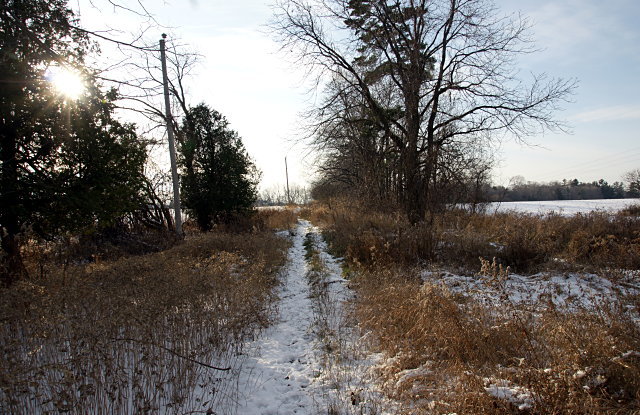 Passmore Avenue looking west from west of Beare Road.
Passmore Avenue looking west from west of Beare Road.
If you’re familiar with Passmore Avenue in Scarborough at all, it’s probably as an unremarkable industrial street that runs in two discontinuous sections between Kennedy Road and Markham Road. But along with the rest of the concession roads in Scarborough, it long predates suburbia: it was laid out and cleared in the 1800s. On an 1878 map, Passmore (then known only as Concession Road 5) stretched 14 km clear across the township of Scarborough with only three short sections missing where the road would have crossed the Rouge River. More modern maps and aerial photos show that Passmore remained a country road crossing Scarborough well into the 1960s, when portions of it started falling to suburban development or neglect.
Although the Passmore name has virtually disappeared over the last 50 years as Scarborough grew from farming township into a suburb, most of the original route still carves its way through the former borough. West of Markham Road, the original road allowance is given over to portions of more than a dozen different suburban roads and park pathways that trace the old road, starting with Gordon Baker Road in the west and continuing to Ketchum Place near Middlefield Road. Drivers can’t follow the entire road thanks to all of the twisty-weavy suburban streets, but multi-use paths directly connect the whole route (except for one block) to allow a continuous 8 km long suburban walking or cycling tour along the old right of way from Victoria Park Avenue to beyond Markham Road. There’s no physical evidence of the original road here other than the straight route through the heart of suburbia.
East of Markham Road, Passmore was never much more than a dirt road through the countryside. Except for three very short half-blocks that still exist, most of it no longer appears on maps and has dropped off the municipal street grid. Yet the old road allowance remains largely open to intrepid hikers in this rural corner of the city. The most accessible portion of Passmore Avenue runs between Gordon Murison Lane and Beare Road, where a line of utility poles stands guard over the old dirt road as it dips into a small valley, passes farm fields on either side, and crosses a small tributary of the Rouge River before climbing back up a low hill at the other end.
A partial tour of the eastern half of Passmore and more photos are below the fold.
While I suppose that's strictly true…
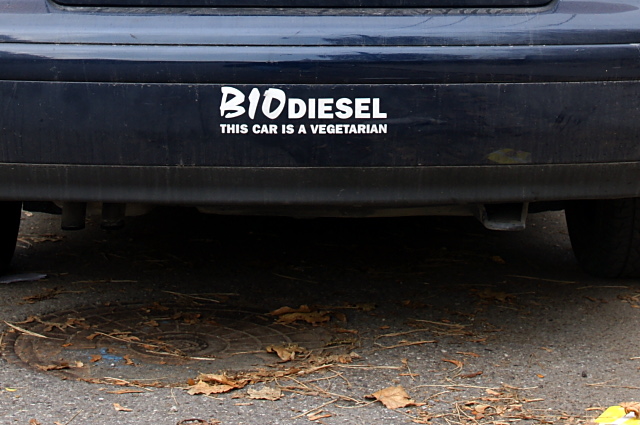
…I still think that my transportation-related carbon footprint is slightly lower than yours, even though my bike is at least partially meat-powered. Also, it’s bad enough that I have to compete for space on the road with two-tonne metal and glass beasts, but now I have to compete with them for food too? Go back to (non-vegetable) oil and stop kidding yourself that you’re doing something noble.
Goin' down the road
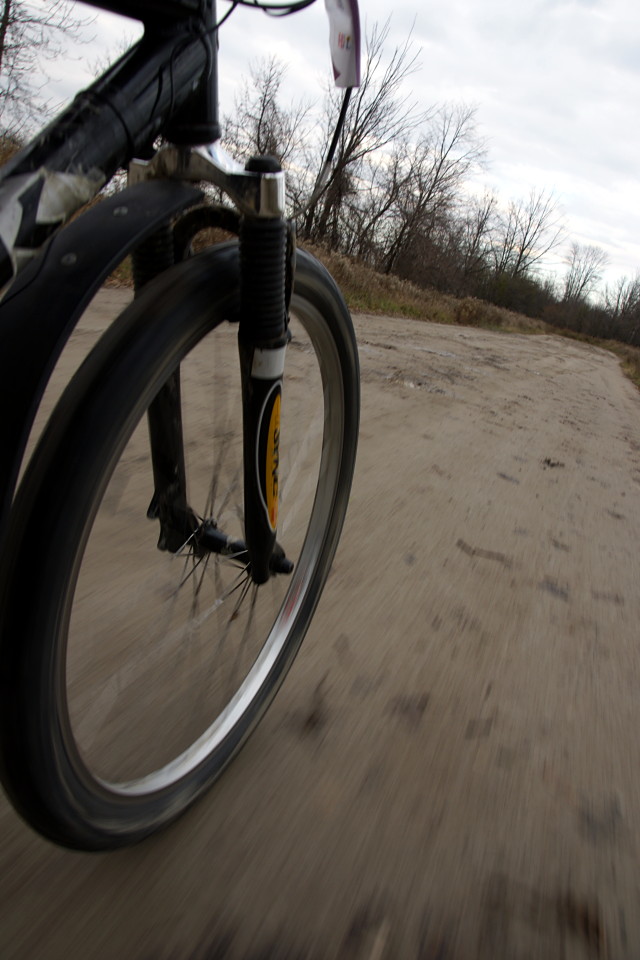
It feels like months since I’ve gotten out for a good ride but I was finally able to hit the (dirt) road yesterday, heading out into the farthest reaches of Scarborough. With the country roads, fields of corn, tangled meadows, and overgrown forests, you’d never know that you were still inside Toronto on the municipal street grid. But then you pass one of the familiar bike route signs (seen here at the rural intersection of Beare Road and the wonderfully-named Plug Hat Road) and you know that you’re still within reach of civilization:
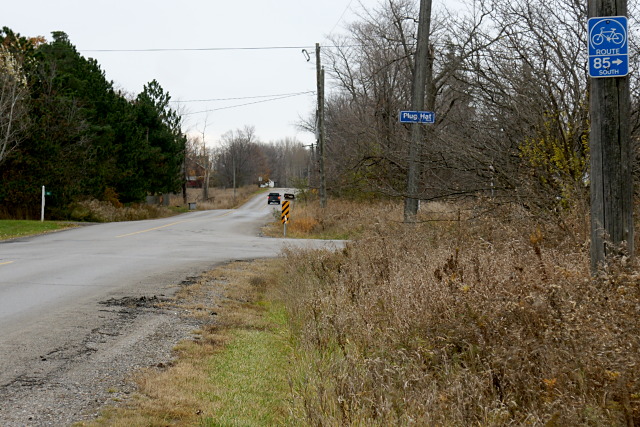
This isolated corner of the city is plagued by illegal dumpers and it shows in the informal signage along the roads:
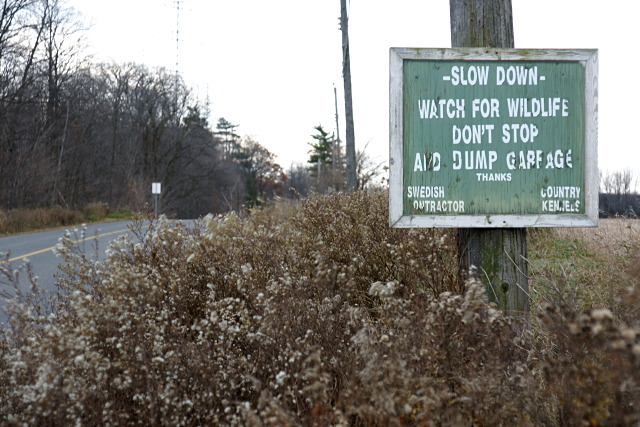
In the last couple of years, northeastern Scarborough and neighbouring northern Pickering has become one of my favourite cycling destinations. The best thing about riding there (or almost anywhere) at this time of year and in cool, rainy weather is that you basically have trails and roads to yourself.
Best comparison chart ever
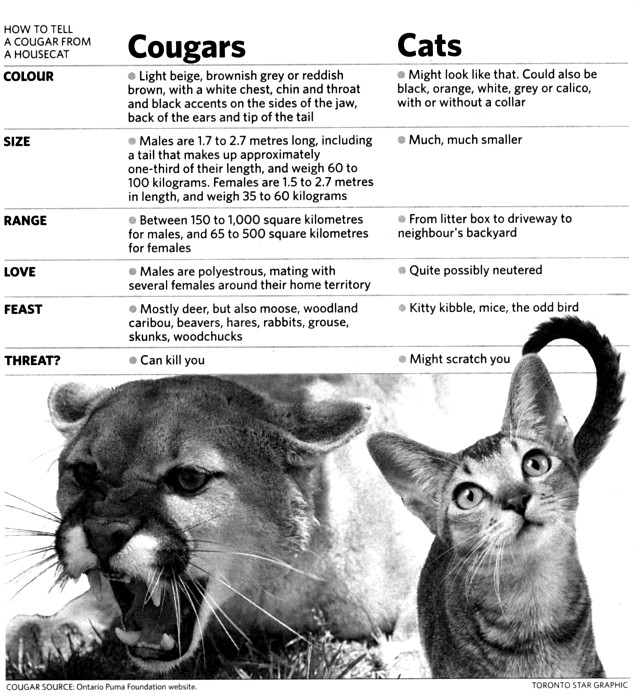
From yesterday’s Star, the above graphic (also available as a too-small PDF) accompanied a story about cougar sightings in Ontario. The relevant sentence from the story:
Some of the animals commonly mistaken for cougars: deer, lynx, coyotes, fishers, dogs, and house cats. Big ones.
Coyotes, I can understand. Lynx? Sure, why not. Deer? Okay, but only if the spotter has never seen a cat of any kind before. House cats? Seriously? You’ve got to be seriously spooked if you’re confusing your neighbour’s kitty for a cougar. Then again, if you have any giant mice hanging around your house, you’d probably want a giant kitty for protection.
Original graphic from the Toronto Star.
Working bikes
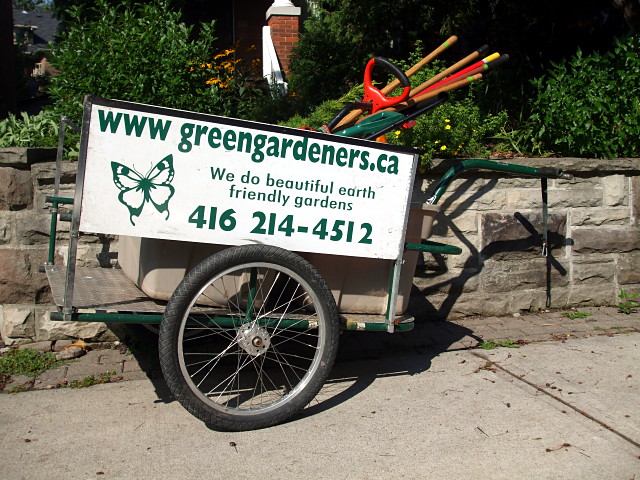
Despite the increasing numbers of people who ride their bikes to work, relatively few people use their bikes as work vehicles.
I frequently pass as many as a dozen landscaping crews on my daily ride through Rosedale and Summerhill, usually with big pickup trucks and trailers hauling all manner of two-stroke trimmers, mowers, and blowers. So it was nice to pass by this bike trailer filled with traditional hand tools the other day. Kudos to Green Gardeners.
I'm from the government, and I'm here to…
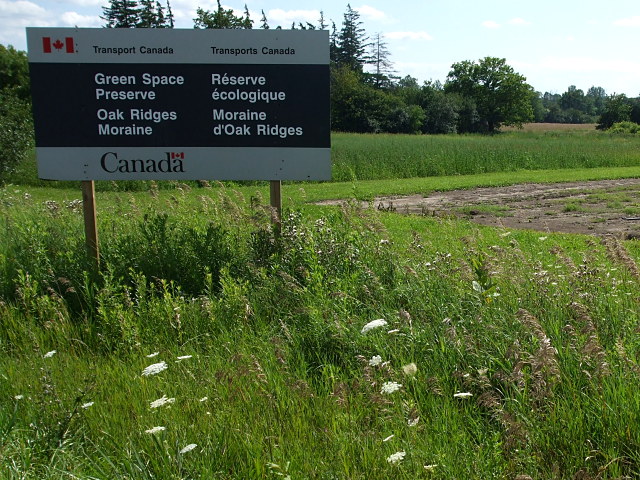
…expropriate your farm, board up your house, and let much of your land lie fallow while we spend 40 years trying to justify building a huge and unnecessary airport on prime agricultural and ecologically sensitive land. Um, I mean, I’m from the government and I’m here to preserve your green space.
(Doublespeak at its finest, as seen on the site of the still-on-the-books Pickering airport.)
